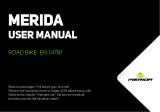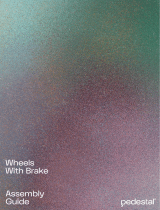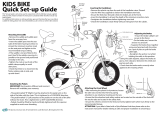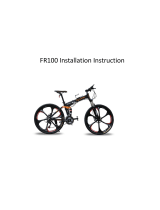
6
Component description MERIDA mountain bike .......................2
Component description MERIDA pedelec ............................4
Some notes on the translation of these original MERIDA operating
instructions ......................................................8
General safety instructions .........................................9
Intended use ....................................................12
Before your first ride .............................................16
Additional information “Before your first ride”
with your MERIDA pedelec .....................................18
Additional information “Before every ride”
with your MERIDA pedelec .....................................22
After an accident ................................................23
Additional information “After an accident”
with your MERIDA pedelec .................................... 25
How to use quick-releases and thru axles .......................... 26
Quick-release ................................................ 26
How to fasten components securely with a quick- release .........27
Thru axles ................................................... 28
Adjusting the MERIDA bike to the rider .............................34
Adjusting the saddle to the correct height ........................35
Adjusting the height of the handlebars ...........................37
Conventional stems ........................................... 38
Adjustable stems ............................................. 39
Stems for threadless systems, the Aheadset
®
-system ............. 39
Correcting the fore-to-aft position and horizontal tilt of the saddle .. 40
Adjusting saddle position and tilt ................................41
Adjusting the brake lever reach ................................. 43
Adjusting the tilt of the handlebars and brake levers ...............44
Special features of MERIDA dirt and freeride bikes .................. 45
Adjusting the saddle height .................................... 46
The brake system ................................................47
Rim brakes .................................................. 49
V-brakes and cantilever brakes ............................... 49
Hydraulic rim brakes ........................................ 50
Functional check ............................................51
Disc brakes .................................................. 52
Hydraulic disc brakes ....................................... 53
Mechanical disc brakes ..................................... 54
The gears ...................................................... 55
Derailleur gears .............................................. 55
Functioning and operation ................................... 55
Checking and readjusting .....................................57
Adjusting the rear derailleur .................................. 58
Adjusting the limit stops ..................................... 58
Adjusting the front derailleur ................................. 59
Multi-speed hubs (internal gear hubs) ...........................60
Functioning and operation ...................................60
Checking, readjusting and servicing ............................61
Adjusting multi-speed hubs ...................................61
Chain - Care and wear ........................................... 62
Chain maintenance ........................................... 62
The wheels and the tires ......................................... 63
Tires, inner tubes, rim tape, inflation pressure .................... 63
Valves .......................................................65
Rim trueness and spoke tension ................................65
Tire puncture ...................................................66
Dismounting wheels ..........................................66
Clincher and folding tires ...................................... 67
Dismounting tires ........................................... 67
Mounting tires ............................................. 68
Tubeless tires (UST tires) ......................................69
Dismounting tires ...........................................69
Repair .....................................................69
Mounting tires .............................................69
Mounting wheels ..............................................70
Special characteristics of carbon ................................... 71
Headset ........................................................73
Table of contents




























